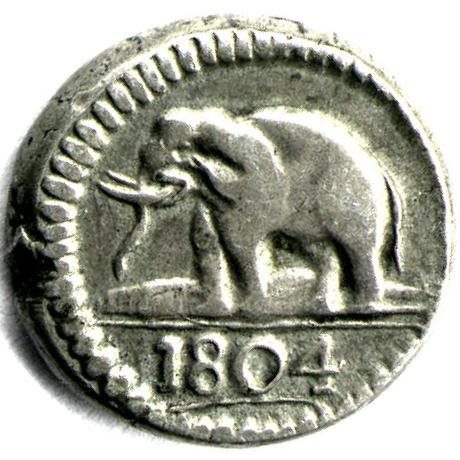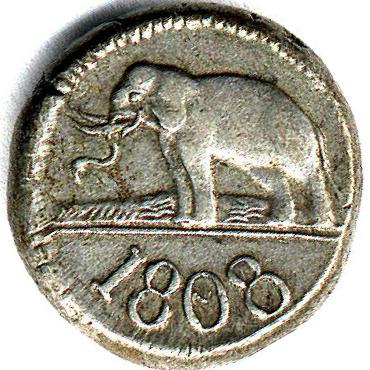
1803-1805
The first contract was signed with Mr. Blume on 1803, February 4th and
provided for the coinage of a silver rix-dollar to weigh 50 to the
pound (Dutch) or 152.5 troy grains and the fineness standard l0/l2ths;
very few rix-dollars were struck of this weight and fineness. The
next contract, dated 1803, June, 8th, ordered that a silver coinage of
rix-dollars and half rix-dollars be struck from Spanish dollars
without any change in the fineness of the metal (891.666) and the
weight of the rix-dollar was reduced to 50 to the pound avoirdupois or
140 grains troy.
The total face value of the locally struck silver
coinage 1803-1805 is approximately 289,000 Rix Dollars.
Of order 60K coins each if equally distributed among 3 years and 2 denominations.
 1803-1805 | |||||
| KM76 | P#14 | 24 | Stiver | Half RixDollar 1803 | coin |
| KM76 | P#15 | 24 | Stiver | Half RixDollar 1804 | coin |
| KM76 | P#16 | 24 | Stiver | Half RixDollar 1805 | coin |
| KM77 | P# 5 | 48 | Stiver | One RixDollar 1803 | coin |
| KM77 | P# 6 | 48 | Stiver | One RixDollar 1804 | coin |
| KM77 | P# 9 | 48 | Stiver | One RixDollar 1805 | coin |
By 1808, the value of the Madras star pagoda had increased to 60
fanams although the local rate still remained at 48. To provide for
this increase the last contract dated 1808, February 17th, also signed
with Mr. Blume, reduced the fineness of the rix-dollar to 10/l2ths
(i.e. .833 the standard of the first contract of 1803). The
weight of 140 troy grains was however retained.
The total face value of the locally struck silver coinage 1808-1809 is
approximately 692,000 Rix Dollars.
Of order 100K coins each if equally distributed among 2 years and 3 denominations.
 1808-1809 | |||||
| KM76 | P#17 | 24 | Stiver | Half RixDollar 1808 | coin |
| KM76 | P#17 | 24 | Stiver | Half RixDollar 1808 | coin Mis-Stuck |
| KM76 | P#22 | 24 | Stiver | Half RixDollar 1809 | coin |
| KM77 | P#10 | 48 | Stiver | One RixDollar 1808 | coin |
| KM77 | P#13 | 48 | Stiver | One RixDollar 1809 | coin |
| KM79 | P# 1 | 96 | Stiver | Two RixDollar 1808 | coin |
| KM79 | P# 2 | 96 | Stiver | Two RixDollar 1809 | coin |
| km79 | p# 2 | 96 | Stiver | Two RixDollar 1809 | Fake Contemporary ? |
No provision was made in any of the three contracts for a double rix-dollar. The first contract of 1803 was specific and only provided for a rix-dollar denomination. The second contract provided for two denominations a whole and a half rix-dollar, while the third contract of 1808 only provided for the weight of the rix-dollar. It is apparent however, that under the terms of the third contract, three denominations of silver coins were struck ; double, single and half rix-dollar.
As listed in table below Pridmore defined variety based objectively on
| P# | Year Deno. | Dots | ON.GO | Lines | Elephant |
| 14 | 1803 24 St | 4 | N | 2 | Left |
| 15 | 1804 24 St | 4 | N | 2 | Left |
| 16 | 1805 24 St | 4 | N | 2 | Left |
| 04 | 1803 48 St | 2 | Y | 2 | Right |
| 05 | 1803 48 St | 4 | N | 2 | Left |
| 06 | 1804 48 St | 4 | N | 2 | Left |
| 07 | 1804 48 St | 4 | Y | 2 | Left |
| 08 | 1805 48 St | 4 | N | 2 | Left |
| 09 | 1805 48 St | 4 | Y | 2 | Left |
| 17 | 1808 24 St | 7 | N | 2 | Left |
| 18 | 1808 24 St | 2 | N | 2 | Left |
| 19 | 1809 24 St | 7 | N | 2 | Left |
| 20 | 1809 24 St | 7 | N | 1 | Left |
| 21 | 1809 24 St | 7 | N | 0 | Left |
| 22 | 1809 24 St | 1 | N | 0 | Left |
| 10 | 1808 48 St | 7 | N | 2 | Left |
| 11 | 1809 48 St | 7 | N | 2 | Left |
| 12 | 1809 48 St | 7 | N | 1 | Left |
| 13 | 1809 48 St | 7 | N | 0 | Left |
| 01 | 1808 96 St | 7 | N | 2 | Left |
| 02 | 1809 96 St | 7 | N | 2 | Left |
| 03 | 1809 96 St | 7 | N | 0 | Left |
According to Pridmore Several writers record in their date lists Double rix-dollars with dates earlier than 1808. All such coins so far traced and recorded are suspect. Those actually examined are silver casts, apparently from moulds made by using an earlier dated copper coin of the 2 stiver denomination for the obverse and the figures in the center of the reverse have been recut to 96.
In 1975 Peter Snartt continuing an analysis by 1956 R. Nott attempted to derive rarity based on the number he found listed in the British Museum, in the collection of Nott and in Auction in the intervening 20-years. I have added to the 97 Silver Stivers from Auction lots, 100 more silver stivers from 4 collections and eBay sold in next 30 years and have slightly adjusted the Rarity.
| Denomination | Source | 1803 | 1804 | 1805 | 1808 | 1809 |
| 96 Stiver | B.M. | - | - | - | 3 | 2 |
| Nott | - | - | - | 4 | 2 | |
| Auction | - | - | - | 14 | 16 | |
| Rarity | - | - | - | R | R | |
| 48 Stiver | B.M. | 4 | 2 | 1 | 4 | 2 |
| Nott | 2 | 7 | 2 | 6 | 13 | |
| Auction | 11 | 20 | 10 | 27 | 29 | |
| Rarity | RR | R | RR | S | S | |
| 24 Stiver | B.M. | 1 | 3 | 1 | 2 | 2 |
| Nott | 1 | 5 | 0 | 12 | 3 | |
| Auction | 9 | 13 | 5 | 28 | 15 | |
| Rarity | RR | R | RRR | S | R |
The 1803 48 Stiver comes in a variety in which the Elephant faces right which is extremely rare(R5). In 1995, 28 of these Silver Dumps from the Dick Ford collection were put on Auction and the prices realized reflect the rarity listed above. My own purchase at Coin-Shows, on Ebay and Auction got me in 6-year 10 of the 12 Year-denomination Types ignoring variety, and I now just need the 1809 96 Stiver and 1805 48 Stiver, for both of which I got images from Jan Lingen. The 96 Stiver is probably RR rather than R. Not sure if some of the forgeries of this coin got counted in, or these coins may changed hands more frequently in those 50 years, and got counted more than once. I will be nice to add in the holding of the Colombo Museum.
Since Collectors don't tend to collect multiple examples of the same coin the distribution of total Auction of few large collections will be biased towards having relatively more of the rare types than the total remaining population of coins of this series. Counting all the smaller Auction with just few Ceylon coins is not practical. eBay probably is biased towards listing of the more common and less expensive types.
There are probably more collectors who collect coins with Elephants than there are collectors who collect Ceylon Coins. The demand for the Elephant coins of Ceylon are therefore significantly higher than for other Ceylon coins of similar rarity. However since the silver are more expensive and more rare to find, the copper dumps are collected and therefore relatively more expensive. i.e. The silver dumps are only about 3 times more expensive than the copper dump coins rather than say 10 times.
Text edited from
* The Coins of the British Commonwealth of Nations
F. Pridmore, London, Spink & Son Ltd., 1960.
* Silver Dump Coinage of Ceylon
R. Nott, Seaby's Coin and Medel Bulletin - 1956 June #457
* The comparative rarity of Ceylon "elephant" dumps
Peter Snartt, Seaby's Coin and Medal Bulletin 1975 June, p. 191-192